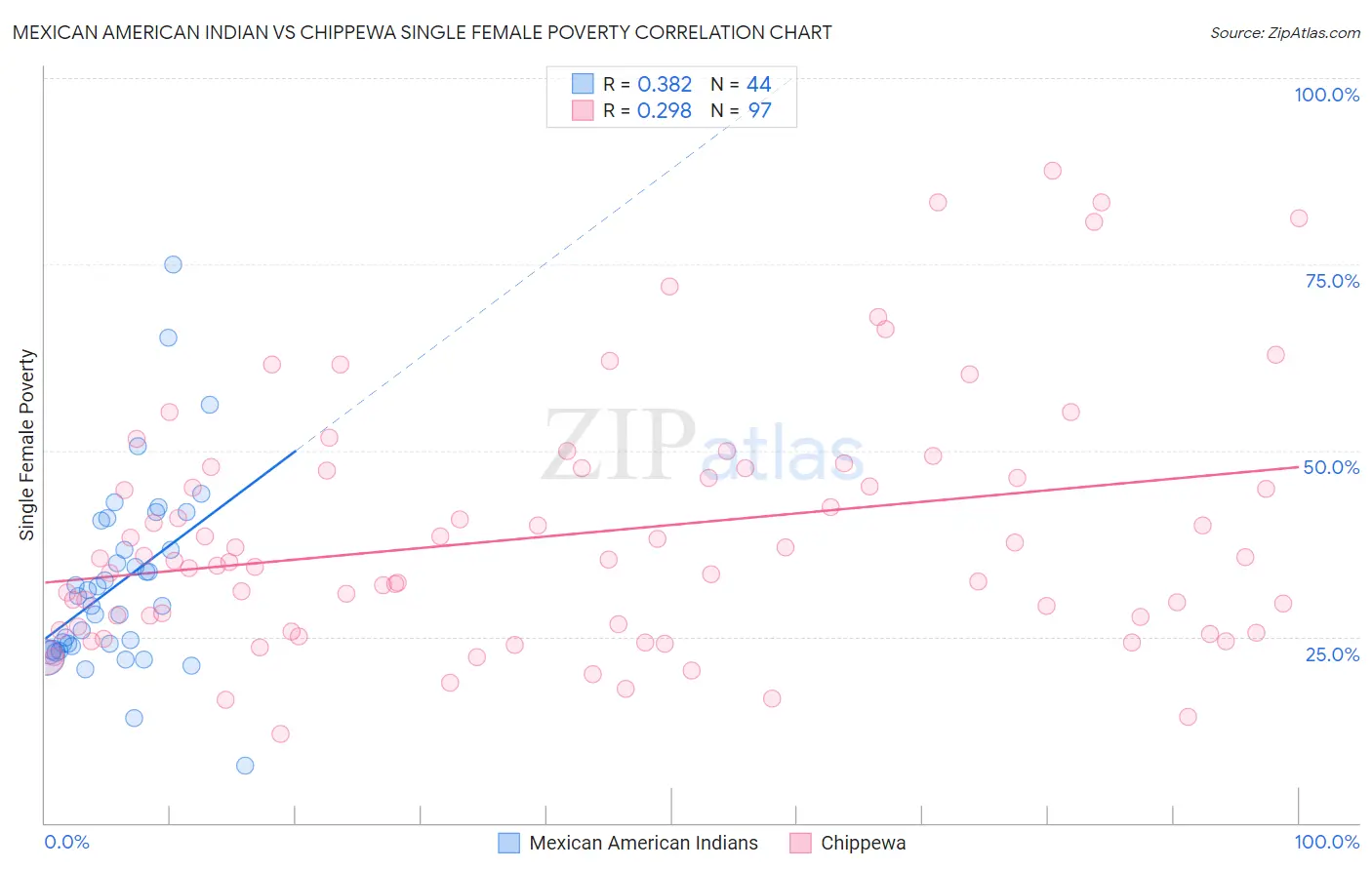Mexican American Indian vs Chippewa Single Female Poverty
COMPARE
Mexican American Indian
Chippewa
Single Female Poverty
Single Female Poverty Comparison
Mexican American Indians
Chippewa
23.4%
SINGLE FEMALE POVERTY
0.1/ 100
METRIC RATING
275th/ 347
METRIC RANK
26.8%
SINGLE FEMALE POVERTY
0.0/ 100
METRIC RATING
323rd/ 347
METRIC RANK
Mexican American Indian vs Chippewa Single Female Poverty Correlation Chart
The statistical analysis conducted on geographies consisting of 315,510,714 people shows a mild positive correlation between the proportion of Mexican American Indians and poverty level among single females in the United States with a correlation coefficient (R) of 0.382 and weighted average of 23.4%. Similarly, the statistical analysis conducted on geographies consisting of 213,087,028 people shows a weak positive correlation between the proportion of Chippewa and poverty level among single females in the United States with a correlation coefficient (R) of 0.298 and weighted average of 26.8%, a difference of 14.9%.

Single Female Poverty Correlation Summary
| Measurement | Mexican American Indian | Chippewa |
| Minimum | 7.7% | 11.9% |
| Maximum | 75.0% | 87.6% |
| Range | 67.3% | 75.7% |
| Mean | 32.2% | 38.7% |
| Median | 29.8% | 35.2% |
| Interquartile 25% (IQ1) | 23.5% | 26.1% |
| Interquartile 75% (IQ3) | 38.6% | 47.5% |
| Interquartile Range (IQR) | 15.2% | 21.4% |
| Standard Deviation (Sample) | 12.7% | 16.5% |
| Standard Deviation (Population) | 12.5% | 16.4% |
Similar Demographics by Single Female Poverty
Demographics Similar to Mexican American Indians by Single Female Poverty
In terms of single female poverty, the demographic groups most similar to Mexican American Indians are Alaska Native (23.3%, a difference of 0.27%), Marshallese (23.3%, a difference of 0.27%), Immigrants from Senegal (23.2%, a difference of 0.53%), Subsaharan African (23.2%, a difference of 0.71%), and Immigrants from the Azores (23.5%, a difference of 0.78%).
| Demographics | Rating | Rank | Single Female Poverty |
| Fijians | 0.2 /100 | #268 | Tragic 23.1% |
| Hmong | 0.2 /100 | #269 | Tragic 23.1% |
| Inupiat | 0.2 /100 | #270 | Tragic 23.1% |
| Sub-Saharan Africans | 0.1 /100 | #271 | Tragic 23.2% |
| Immigrants | Senegal | 0.1 /100 | #272 | Tragic 23.2% |
| Alaska Natives | 0.1 /100 | #273 | Tragic 23.3% |
| Marshallese | 0.1 /100 | #274 | Tragic 23.3% |
| Mexican American Indians | 0.1 /100 | #275 | Tragic 23.4% |
| Immigrants | Azores | 0.0 /100 | #276 | Tragic 23.5% |
| Pennsylvania Germans | 0.0 /100 | #277 | Tragic 23.6% |
| Immigrants | Nonimmigrants | 0.0 /100 | #278 | Tragic 23.6% |
| Alaskan Athabascans | 0.0 /100 | #279 | Tragic 23.6% |
| Immigrants | Latin America | 0.0 /100 | #280 | Tragic 23.7% |
| Immigrants | Zaire | 0.0 /100 | #281 | Tragic 23.8% |
| Guatemalans | 0.0 /100 | #282 | Tragic 23.8% |
Demographics Similar to Chippewa by Single Female Poverty
In terms of single female poverty, the demographic groups most similar to Chippewa are Seminole (26.8%, a difference of 0.10%), Kiowa (26.9%, a difference of 0.41%), Yup'ik (26.6%, a difference of 0.84%), Choctaw (27.2%, a difference of 1.4%), and Arapaho (26.4%, a difference of 1.5%).
| Demographics | Rating | Rank | Single Female Poverty |
| Immigrants | Somalia | 0.0 /100 | #316 | Tragic 25.8% |
| Ottawa | 0.0 /100 | #317 | Tragic 26.0% |
| Chickasaw | 0.0 /100 | #318 | Tragic 26.3% |
| Blacks/African Americans | 0.0 /100 | #319 | Tragic 26.4% |
| Arapaho | 0.0 /100 | #320 | Tragic 26.4% |
| Yup'ik | 0.0 /100 | #321 | Tragic 26.6% |
| Seminole | 0.0 /100 | #322 | Tragic 26.8% |
| Chippewa | 0.0 /100 | #323 | Tragic 26.8% |
| Kiowa | 0.0 /100 | #324 | Tragic 26.9% |
| Choctaw | 0.0 /100 | #325 | Tragic 27.2% |
| Creek | 0.0 /100 | #326 | Tragic 27.4% |
| Dutch West Indians | 0.0 /100 | #327 | Tragic 27.5% |
| Apache | 0.0 /100 | #328 | Tragic 27.7% |
| Menominee | 0.0 /100 | #329 | Tragic 27.8% |
| Hopi | 0.0 /100 | #330 | Tragic 28.0% |